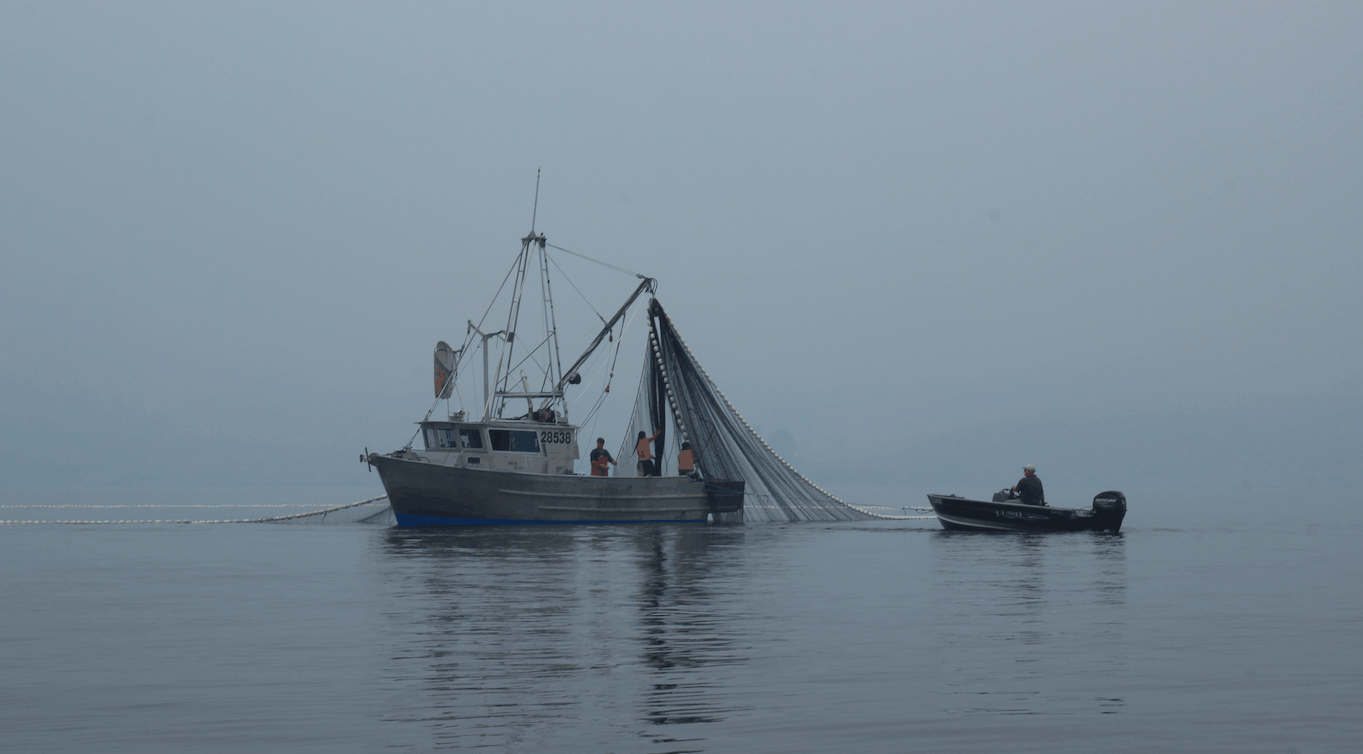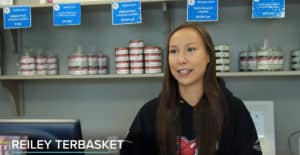At the end of August, we had the chance to visit the Okanagan to spend some time with an amazing Indigenous Co-op: River Select.
Smoke from the August wildfires plaguing northern BC was evident in the Kelowna area during our visit, but the natural beauty of BC wasn’t hidden by the haze. Our drive into the Lower Fraser Valley was highlighted by corn fields, winding roads, and lush green landscapes. The area is packed with the promise of good food and good people.
Harrison Select

We were fortunate to encounter both when we met with Dave Moore, Manager of River Select Co-operative on the Sts’ailes First Nation near the Chehalis and Harrison Rivers. Dave gave us a tour of the fish processing site operated by the Sts’ailes and Scowlitz First Nations. This partnership, dubbed Harrison Select, brings together fishers from both Nations to brand and market a product that is harvested using traditional learnings. The logo for Harrison Select is the Sasquatch walking alongside a salmon: the Sts’ailes First Nation recognize the Sasquatch as the caretaker of the land, and the Scowlitz recognize the salmon as their logo.
(Unfortunately, there were no Sasquatch sightings during our visit.)

Dave said many First Nation communities that rely on the fishery have been concerned with declining stocks and overharvest resulting from commercial activity over the last 150 years. River Select was created in response to this destructive practice. The co-op allows relatively small-scale First Nation-owned fisheries to conduct sustainable harvest using sustainable methods while finding efficiencies through co-operation. By working together, the eight members can maintain feasibility allowing them to preserve their traditional fisheries.
“Our co-operative came into being when it became clear that these small artisanal fisheries of yesteryear, they can’t survive in today’s global economy because it’s all about large, consistent volumes year-round,” said Dave. “…we designed a fisheries co-operative that could provide the financing, the infrastructure, the professionals in order to help do the kinds of things they couldn’t afford to do as a single small enterprise, but could do collectively if they shared these things.”
While the co-op only employs four people directly, it fosters the livelihoods of hundreds of Indigenous fishers across BC.
“We invest in value-adding that fish so the community and the fishermen see more value from their efforts,” Dave said.
Each Nation maintains a storefront where they sell their own branded products that are distributed by the co-op. This complements the online store and allows each Nation to capitalize on tourists hungry for local salmon.
As a biologist who has worked in the fishing industry for over 30 years Dave knows a thing or two, so we had to ask: ‘How do you cook the perfect salmon?’ His favourite: Chinook salmon, barbequed on a cedar plank.
With mouths watering, we purchased some salmon jerky from the Sts’ailes store to satisfy our craving on the drive home.
Okanagan Select and Osoyoos Lake
On our second day, we met Howie Wright with Okanagan Nation Alliance, a representative of eight Nations in the area and the owner of Okanagan Select. Howie gave us a tour of Okanagan Select’s storefront, processing site, freezers, and dry storage areas.

After our tour of the Westbank-based site, Howie asked if we could join him at the landing ground on Osoyoos Lake where he had arranged for us to meet some local fishers. The Backroad Diaries team is always up for a road trip, so we set off for Osoyoos.
If you’re wondering how to get to Osoyoos Lake when heading south, Howie’s directions were spot on:
- Turn left on road 22 off highway 97
- Turn right onto Black Sage Road by the old barns
- Turn left by the second set of houses where a toilet used to be
- Keep left until you reach the lake
When we arrived we met Louie, the owner of Louie’s Extreme Fishing, who took us out on the lake to meet some local fishers. With the smoke thickening, we were unable to appreciate our mountainous surroundings, but that allowed us to focus on fishing.
We also met Reagan, a local fish harvester. Using sonar technology, Reagan can detect a cluster of fish, then cast out a net to surround the fish and pull them up. Once near the surface, a packing boat (a smaller boat filled with totes) moves alongside the fishing boat to receive the catch. The fish are then poured into the totes and brought ashore.

Community Fishery
Louie told us that that week the fish weren’t being harvested commercial purposes, but for the community food fishery. The fish harvested on the day we visited would go to Merritt, and fish from the following day would head to Vernon. Communities rely on the fishery for more than just revenue: the co-op helps preserve a way of life that has been practiced for thousands of years.
Limləmt, thank you, to Dave, Howie, Louie, and everyone else we met throughout the Okanagan for your hospitality and kindness.

 Written by
Written by 

